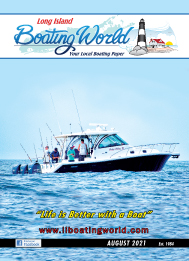
Carbon Monoxide (CO) – An Odorless, Colorless Predator … In most respects boating is a healthy outdoor activity that gives us opportunities to exercise and relax at the same time. During any given day on the water, boating enthusiasts go fishing, swimming, tubing, skiing, and floating on a raft while we work on our tans. However, carbon monoxide, or CO, lurks in the shadows. Common places it can be found are on deck, in the cabin, and it can be found on the surface of the waters that surround your boat. If undetected it can result in serious illness or worse in extreme circumstances. This safety tip focuses on what the Skipper can do to prevent carbon monoxide poisoning. Symptoms … Carbon monoxide can be fatal. Alert Skippers will keep an eye on his or her passengers to look for early symptoms of CO poisoning. These include confusion, weakness, dizziness, headache, and nausea. As symptoms become more severe, loss of muscle control, blurred vision, extreme headache, fainting, and convulsions occur. These symptoms are very serious. If you see a passenger or passengers on your boat showing symptoms, react quickly. Take Action … Get everyone out of the cabin and onto the deck to get fresh air. If underway, slow down and open all of your windows. If you see excessive amounts of exhaust at the rear of the boat slow down and drive into the wind as much as possible to prevent the exhaust from being sucked into the cockpit and cabin by the boat’s forward motion. If you need to return to port via a downwind course you may want to add a bit of tacking to your ride home. If anyone on board is being seriously impacted call the Coast Guard, Police Boats, or Harbormasters and request medical emergency assistance. Prevention … The number one source of carbon monoxide on a boat is the engines. If your engines are inboard be certain to make sure the exhaust manifolds are in good conditions and all gaskets are inspected and replaced as necessary. Outboard engines are less of a problem, but they too emit exhaust fumes that can be sucked into the cockpit and cabins. An excessively smoky outboard engine should be repaired, or replaced. As an additional precaution place a reasonable number of CO detectors throughout your boat. If these are battery-powered change the batteries each season. In addition to the boat’s engines, propane cooktops emit carbon monoxide. If you don’t have an electric range or oven onboard, a propane cooktop should be used out of the cabin in the cockpit. Hidden Sources of Carbon Monoxide … On most boats, carbon monoxide is emitted at the transom of the boat. At idle speeds, it can accumulate close enough to the transom to find its way into the cockpit. Be aware too that carbon monoxide will accumulate under and behind the swim platform. Before jumping into the water after anchoring, allow time for the CO to dissipate. External Sources of Carbon Monoxide … Exhaust emissions don’t just come from your engine. Other boats anchored or moored near your spot in the cove emit carbon monoxide. This will occur as the approaching boat moors or passes you as it returns home. In addition, many boats use generators while moored or anchored. Water Sports Risks … Many boaters ski, wakeboard, go tubing, and platform drag (holding on while the boat is underway on the water). Doing these activities too close to the boat’s transom creates heightened carbon monoxide exposure delivered within the engine’s exhaust fumes. In addition, towing yourself too close to the transom of a boat while it is underway is dangerous. A smart Skipper will not allow this activity to take place on his or her boat. In many states, this is banned. Don’t Expose Yourself to Getting Chopped Up … Performing watersports in very close proximity to the propellers beneath the transom or swim platform of the boat is extremely dangerous. Participants can slip and get pulled into the propellers beneath the swim platform.
This is a very real risk that should not be taken lightly. Smart skippers keep their passengers’ safety in mind at all times.
Likewise, extreme boating enthusiasts should keep their friends’ best interests in mind as well. Safety Precautions … If you are the operator of the boat make sure everyone being towed is wearing a proper, and right-sized PFD at all times while being towed. Also, know that operating a boat while under the influence of alcohol or drugs is extremely unsafe and against the law. Fuel Risks … Much like carbon monoxide risks, fuel risks expose boaters to danger. Before fueling, make sure all windows and hatches are closed, turn off cooktops and grills, don’t smoke, do not use electrical switches, ask passengers to step ashore, be aware that gasoline vapors are heavier than air and will gravitate to the bottom of the boat, before restarting the engines do a smell test for vapors, and run the blower.
You can learn more from Captain Steve Stolze by visiting BoatOpsAndSafety.com.
While there explore the site and navigate through Captain Stormalong’s Tall Tales Blog.
Remember, Smart Boating is Safe Boating!!!
